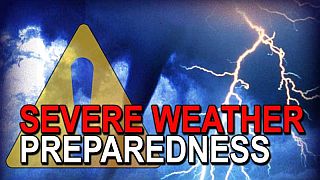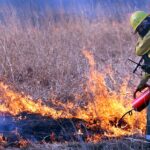 The Indiana Department of Homeland Security (IDHS) is encouraging Hoosiers to plan ahead for extreme weather as part of Severe Weather Preparedness and Flood Awareness Week, March 19-25.
The Indiana Department of Homeland Security (IDHS) is encouraging Hoosiers to plan ahead for extreme weather as part of Severe Weather Preparedness and Flood Awareness Week, March 19-25.
“The arrival of spring in Indiana means an increased threat for severe weather,” said John Erickson, Director of Public Affairs at IDHS. “This year, Hoosiers across the state have already experienced some of the severe weather that accompanies spring, and this week serves as a great reminder to prepare now before any future severe weather strikes.”
Planning and preparation can help minimize weather-related deaths, injuries and property damage. IDHS is encouraging Hoosiers to build a preparedness kit, identify shelter and practice their plan during this year’s preparedness week. Ten important items to include in your family’s disaster kit include:
1. Food and water for three days (include one gallon of water per person, per day)
2. Battery operated all hazard radio (receives more than 60 types of emergency alerts)
3. Flashlight
4. Extra batteries for radio and flashlight, if needed
5. First aid kit
6. Extra clothing, sturdy shoes, rain gear, blankets and personal hygiene items
7. List of emergency phone numbers
8. Important documents (copies of photo ID, social security card, insurance and banking information)
9. Cash (small bills. Power outages can limit ability to use ATMs and credit cards)
10. Special items (baby formula, insulin, life sustaining medication, pet supplies)
As part of Severe Weather Preparedness Week, on Tuesday, March 21, there will be a statewide tornado drill at 10:10 a.m. and 7:35 p.m. These drills provide a valuable opportunity for families, schools and businesses to practice their severe weather emergency plans. Some ways families can practice during the statewide tornado drill are:
- Take household members – quickly but calmly – to the location they would move to in severe weather, ideally a basement. If a basement is not available, go to an interior room on the lowest level with no windows. Storm cellars also offer excellent protection.
- Practice moving under a sturdy table or desk, or covering up with pillows, blankets, coats or a mattress to protect the head and body from flying debris.
- Walk through potential evacuation routes, both from the home and the neighborhood.
- Conduct a family drill in which children pretend to call 911 and calmly talk with an emergency dispatcher (a family member or friend can be on the other end of the line, requesting appropriate information).
Finding suitable shelter is another important aspect to preparing for severe weather, such as a storm or tornado. If living in a mobile home or similar structure, it is important to locate a safe shelter in advance. For those living in homes or apartment buildings, residents should take shelter in the lowest level of the building, away from windows and doors.
Flooding is also an issue Hoosiers may encounter during the spring months. Driving on flooded roadways can often place Hoosiers and emergency response personnel in unnecessary danger. Never drive through flooded roadways, even if the water appears shallow. The road may have washed out under the surface of the water.
Floods can be very expensive. The National Flood Insurance Program is run by the Federal Emergency Management Agency (FEMA), and purchasing flood insurance is a way that homeowners can protect their homes. FEMA’s FloodSmart website at www.FloodSmart.gov has created a tool to quickly estimate the cost of damages from various amounts of floodwater in a home, and includes resources to help homeowners prepare their homes for a flood.
To find out more about preparing for severe weather and floods, visit www.GetPrepared.IN.gov.
Severe Weather Myths Hoosiers Should Be Wary of This Spring
Everyone has heard “dos and don’ts” when it comes to severe weather. For Severe Weather Preparedness and Flood Awareness Week 2017, the Indiana Department of Homeland Security is debunking a few myths that may help protect Hoosiers this spring.
Myth #1: Any Building is Safe During a Tornado
Manufactured buildings often can’t stand up to the wind speed and pressure, and are not safe shelters during a tornado. Hoosiers living in mobile homes or similar structures should talk to friends, family or neighbors to find a safe shelter in advance.
Permanent structures are best for shelter during a tornado, especially if they have a basement. Interior, lower level rooms away from doors and windows can be an adequate backup plan.
Myth #2: Seek Shelter in an Underpass During Tornadoes
When traveling during a tornado, an underpass is one of the worst places to take shelter. Wind speeds can increase while flowing under the structure, and serious injuries can occur. Seek shelter in a permanent structure (even better if it has a basement).
If there is no safe building nearby, look for a depression or ditch that is safely and significantly lower than the level of the roadway. Lie down in that area. Hands and arms should be used to protect the head and neck. If there is no ditch or low areas nearby, park and stay in the car and continue to wear a seatbelt. Lean over to stay below window level. If possible, use hands, blankets or coats to protect the head and neck.
Myth #3: Open Windows Prior to Tornado Strike to Equalize Pressure Inside the House
Opening windows does not help equalize pressure, and spending the time cracking those windows can use up valuable seconds needed to take shelter. When an alert sounds on television, phones or all hazard radios, seek shelter right away.
Myth #4: If outside in a thunderstorm, seek shelter under a tree to stay dry.
Most lightning deaths and injuries occur when people are caught outdoors. Seek shelter right away, preferably in a building or hard top automobile. Although injuries can occur to someone in a car if lightning strikes the vehicle, being inside a hard-topped vehicle is better than outside. If no shelter is available, crouch in a low area such as a ravine or valley and stay alert for flash floods.
Myth #5: It’s OK to Drive Across a Flooded Roadway if it Doesn’t Look Too Deep
Never attempt to cross a flooded road, even if it seems shallow. Water can conceal dips, or worse, flood waters can damage roadways, washing away the entire road surface and a significant amount of ground.
Myth #6: Playing in Flood Water is a Safe Tradition
While playing in water can be a lot of fun, flood water can contain unknown contaminants such as oil and other waste that can impact health. Unseen dangers, like large rocks, tree limbs or strong water currents, also pose a threat when playing in flood water. Additionally, do not try to cross moving water on foot. As little as a few inches of flowing water can knock adults off their feet.
Myth #7: Flooding Only Impacts Properties Near Rivers
Floods can impact properties no matter where they are located, but especially in a low-lying area, near water or downstream from a dam. Even very small streams, gullies, creeks, culverts, dry streambeds or low-lying ground that appears harmless in dry weather can flood. Keep storm drains clear to help combat localized flooding and monitor conditions closely during rain events.
Seven were mentioned, but really, here’s one more…
Myth #8: There’s No Way to Prepare for Disasters
Taking steps now can make a big difference during an emergency. Making a plan, building a preparedness kit and learning about common local risks can help increase safety. Being a little prepared for severe weather is better than doing nothing, and may help keep family members safe. Visit the Indiana Department of Homeland Security site GetPrepared.IN.gov for more information and resources for severe weather and floods.














